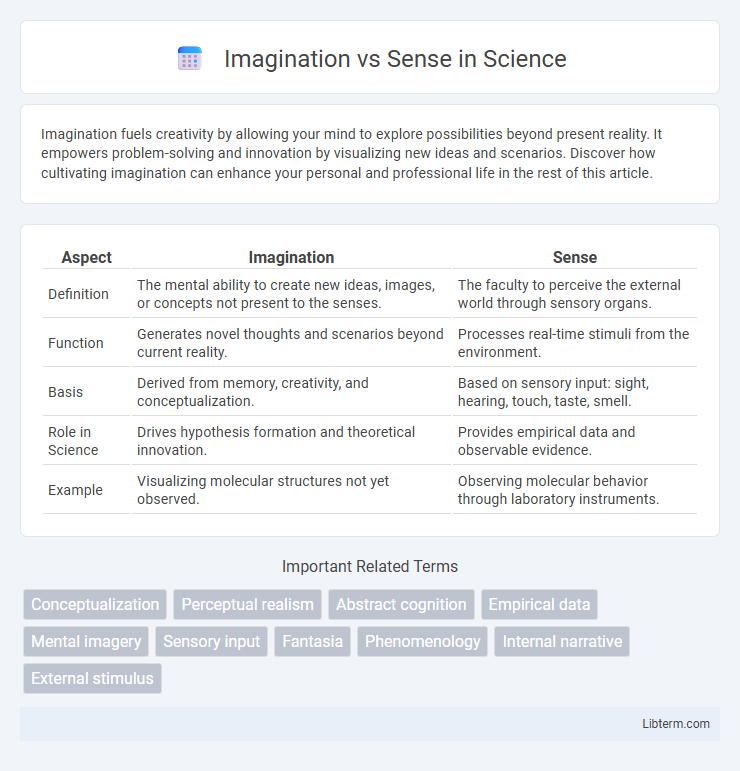Imagination fuels creativity by allowing your mind to explore possibilities beyond present reality. It empowers problem-solving and innovation by visualizing new ideas and scenarios. Discover how cultivating imagination can enhance your personal and professional life in the rest of this article.
Table of Comparison
| Aspect | Imagination | Sense |
|---|---|---|
| Definition | The mental ability to create new ideas, images, or concepts not present to the senses. | The faculty to perceive the external world through sensory organs. |
| Function | Generates novel thoughts and scenarios beyond current reality. | Processes real-time stimuli from the environment. |
| Basis | Derived from memory, creativity, and conceptualization. | Based on sensory input: sight, hearing, touch, taste, smell. |
| Role in Science | Drives hypothesis formation and theoretical innovation. | Provides empirical data and observable evidence. |
| Example | Visualizing molecular structures not yet observed. | Observing molecular behavior through laboratory instruments. |
Understanding Imagination and Sense
Imagination involves the mental ability to create images, ideas, or concepts that are not present to the senses, enabling creative thinking and problem-solving. Sense refers to the direct perception of reality through sensory organs, providing accurate data about the external environment. Understanding imagination and sense highlights the balance between abstract cognitive processes and concrete sensory input essential for comprehending and interacting with the world.
Defining Imagination: Power of the Mind
Imagination is the cognitive ability to create mental images, scenarios, or concepts beyond immediate sensory input, harnessing the brain's creative power. It enables innovation, problem-solving, and abstract thinking by transcending the limitations of current reality and sensory experience. Imagination fuels artistic expression, scientific discovery, and visionary ideas by tapping into the boundless potential of the human mind.
The Role of the Senses in Perception
The senses serve as primary channels for gathering information from the external environment, enabling perception through sensory data such as sight, sound, touch, taste, and smell. Sensory receptors detect stimuli and transmit signals to the brain, where these inputs are integrated and interpreted to form a coherent understanding of reality. Imagination builds upon this sensory foundation by manipulating and recombining sensory experiences to create mental images and concepts beyond immediate perception.
Imagination vs Sense: Core Differences
Imagination involves the creative ability to form new ideas, images, or concepts not present to the senses, while sense refers to the direct perception of reality through sensory organs like sight, hearing, and touch. The core difference lies in imagination's subjective and constructive nature versus sense's objective and receptive function. Imagination enables abstract thinking and innovation, whereas sense grounds experiences in tangible, external stimuli.
How Imagination Shapes Reality
Imagination profoundly shapes reality by enabling humans to conceive possibilities beyond immediate sensory experiences, effectively constructing mental models that guide behavior and innovation. Cognitive neuroscience reveals that neural networks involved in imagination overlap with those for perception, suggesting imagined scenarios influence real-world decision-making and problem-solving. This dynamic interplay between imagination and sensory input drives creativity and shapes cultural, technological, and scientific advancements.
The Limitations of Human Senses
Human senses are inherently limited in perceiving the full spectrum of reality, constrained by biological ranges such as the visible light spectrum or audible frequencies. Imagination extends beyond these sensory boundaries, allowing the mind to construct concepts, scenarios, and abstract ideas that physical senses cannot detect. This contrast highlights the essential role of imagination in overcoming the inherent sensory restrictions, enabling innovation and deeper understanding beyond empirical data.
Interplay Between Imagination and Sensory Input
The interplay between imagination and sensory input shapes human perception by integrating real-world stimuli with creative mental constructs, enhancing cognitive flexibility and problem-solving. Sensory input provides the foundational data which imagination transforms, enabling individuals to visualize possibilities beyond immediate reality. This dynamic interaction supports learning, memory formation, and adaptive behavior through continuous feedback between sensory experiences and imaginative exploration.
Examples of Imagination Overriding the Senses
Dreams vividly illustrate imagination overriding the senses, as the mind creates sensory experiences without external input. Optical illusions demonstrate how imagination influences perception, causing the brain to interpret sensory data in unexpected ways. Creative visualization techniques in sports and therapy actively harness imagination to modify physical sensations and improve performance or well-being.
Harnessing Imagination for Creative Growth
Harnessing imagination acts as a catalyst for creative growth by enabling innovative thinking beyond sensory limitations. The mind's ability to visualize abstract concepts fosters problem-solving and artistic expression, driving transformative ideas. Engaging imagination systematically cultivates originality and expands cognitive potential in various creative disciplines.
Achieving Balance: Integrating Sense and Imagination
Achieving balance between imagination and sense requires integrating creative thinking with practical reasoning to enhance problem-solving and decision-making. Harnessing imagination fosters innovation and novel ideas, while grounding these concepts in sensory input ensures feasibility and effective implementation. This integration enables individuals and organizations to navigate complex challenges by combining visionary insights with realistic, data-driven strategies.
Imagination Infographic

 libterm.com
libterm.com